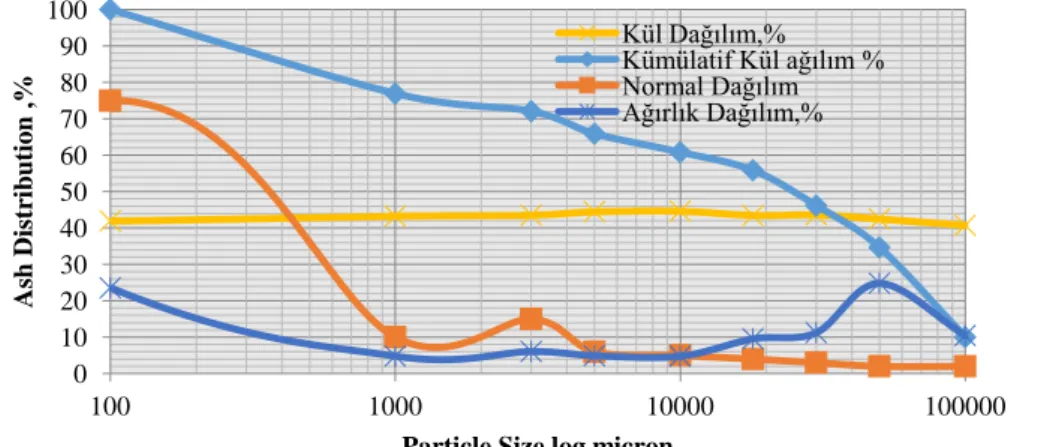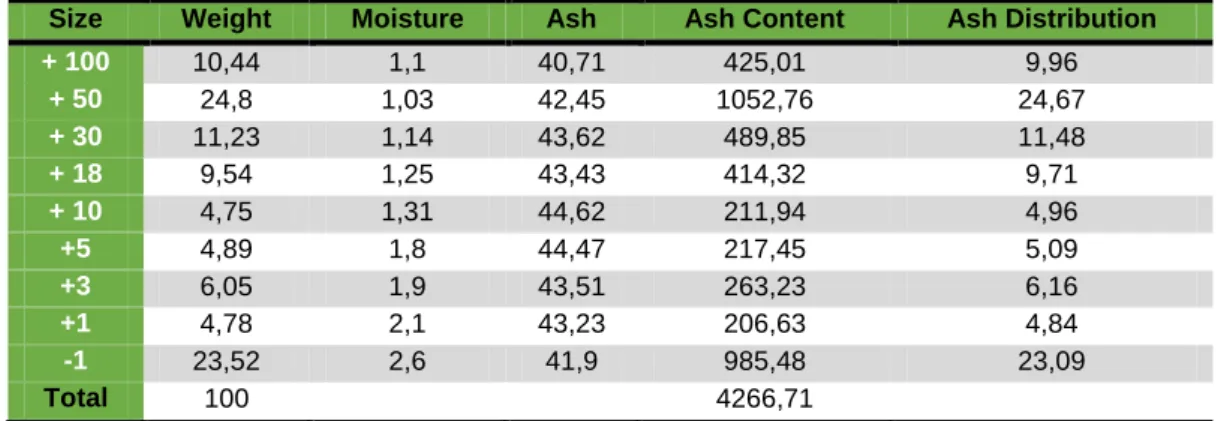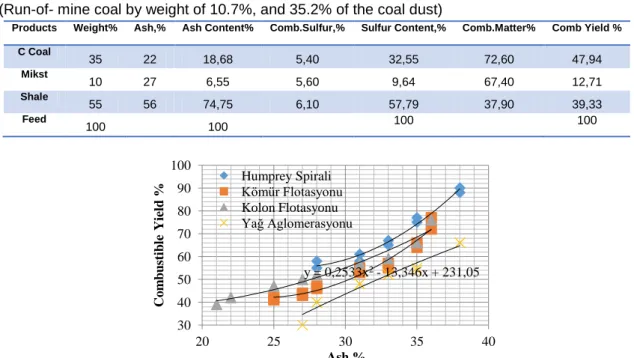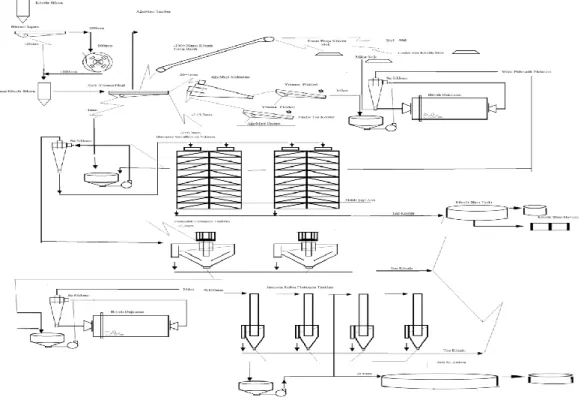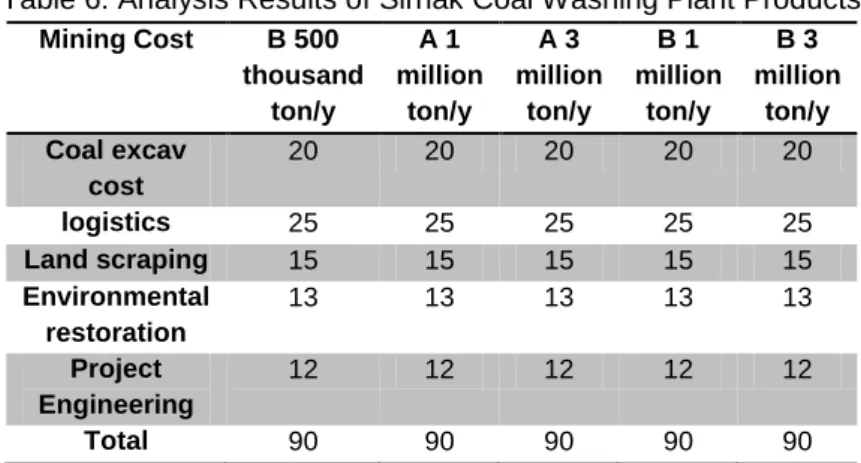STUDY OF WASHABILITY OF FINE ŞIRNAK ASPHALTITE
-ASSESMENT OF ADVANCED WASHING PLANT COST
Yıldırım İ. Tosun
Mining Engineering Department, Şırnak University, Şırnak, Turkey
Abstract— The total amount of asphaltite resource in reserves and production in Şırnak City are over 120 million tons of available asphaltite reserve and about 600 thousand tons per year, respectively. The asphaltite is used in mainly coal boilers for direct heating, and also in industrial furnaces as coal fine. The coal power plants use asphaltite about 400.000 tons per annum in the boiler. The most effective and cost-effective technologies are needed for clean asphaltite production in today's modern technologies.
In this investigation, in Şırnak City there are valuable asphaltite reserves on possible cleaning, containing 42% Ash, 6.9% total S (Calorific value 4570 kcal/kg) the standard coal washability studies Şırnak asphaltite were carried out and possible advanced washing plant design was developed and discussed on cost risk data. Regarding this study capital and operational cost risk were calculated, optimum plant units are proposed as larcodem or humprey spiral and column and flotation units. Regarding the proposed project capacities, the capital and operational costs the cost parameters for projected design were determined. Finaly, the production of the qualified asphaltite were managed with 25% ash in clean asphaltite..
Keywords: Column Flotation, Coal Flotation, Coal washing plant, investment cost, feasibility of asphaltite washing, coal cleaning cost
1. Introduction
The almost 211TWh total electricity in 2011, Turkey were produced primarily from imported natural gas and domestic coal [1-4]. The total amount of asphaltite resource in reserves and production in Şırnak City are over 82 million tons of available asphaltite reserve and 400 thousand tons per year, respectively [5]. The most effective and cost-effective technologies are needed for clean coal products in today's modern technologies [5-9]. Turkish coal industry needs washing technologies and high performances at lower cost with various types of local coals.
Evaluation of natural resources, in parallel with the energy needs of our country will provide economic benefits by reducing fuel imports. Basically, energy production is made from imported natural gas and has a 46% share of health. After the energy production from coal imported natural gas is located in the second row and is provided by burning coal in thermal power plants with a share of 26% (TKI, 2013). Depending on the future energy demand, the ratio is expected to increase. A total of 83 million tonnes per annum of lignite and coal in boilers and industrial furnaces production was evaluated as the need for heating and energy. Quality coal ash minerals comprise micronized size particles[10]. In this study, the opening of the quarry closed in Sirnak region and the high-calorie but ash and sulfur content can be produced by washing it is considered to be the economic contribution of higher asphaltites. Şırnak asphaltites the washability studies made by developing potential flowsheets were compared accordingly wash
washing plant investment and operating costs. The result of the feasibility study has identified suitable premises.
Asphaltites of Sirnak and Hakkari in Turkey's Southeastern Anatolia is located in the provinces. 120 million tons of proven reserves of Sirnak and Hakkari possible asphaltite of 0.2-1% moisture, 37-65% ash, sulfur burning 6,3-7.5% total sulfur 5.5-5.7%, 60-65% volatile matter and 2800-5600 kcal / kg has a lower temperature. Şırnak asphaltites beds are distributed or block-shaped space rock in the vein location [3]. Avgamasya and production is done in Karatepe veins approximately 15 years. Avgamasya and Karatepe veins 15-25 and 10-20 m thick clumps form. Also Hakkari, Uludere district was spread around 1-20 m thick layer of scattered asphaltites and as bed layers and as veins.
as well as limestone bed rock, shale, marl clay, marl and argillaceous limestone is located. Şırnak asphaltites coal is soft with shale ash and macro size boyutta calcite micronized minerals as pyrite and pyrrhotite deposits are widely used in coal and shale asphaltites.
1.1 Washing coal with Larcodems and Humphrey Spirals
Larcodems medium types are widely used in coal washing operation for low and medium density. The separator shows efficient performance in cleaning and just one unit Larco in a single cycle can provide high capacity of 50 ton/h, such as washing. This reagent is provided to those in severe ambient conditions can yield high as 1-6 mm in size and are determined can be reduced to less than 15% of ash content (Anonymous, 2015). Especially hard washable mixed product obtained in coal and enables you to process these musk again after shredding (Kemal and Aslan, 1999, Rules, 1991).
Humphrey spirals in the washing of coal in the high and medium intensity and especially in the washing of the pyritic sulfur in the coal is preferred widely (Anonymous a, b, c, 2015). In the high density and high ash coals Humphrey spirals in a specific amount during the washing was observed to increase the amount of mixed product.
1.2 Washing with the Coal Flotation
Flotation for washing the fine size coal (Jameson, 2001) is a method most commonly used. Some studies of coal particle size and density of mineral distribution in coal flotation (Warner, 1985) determined that significant side kinetic and may affect efficiency. Studies particle size increases, as can be shown that the yield decreases rapidly (Schubert, 2008). Generally yield falls in the flotation of coarse coal, but flotation rate is very low. Particle size is too big, not sticking on the bubbles. In contrast, a high efficiency in the fine coal flotation and flotation kinetics also increase (Gupta et al., 2001). In contrast, flotation rate depends strongly on the grain size medium size coal particles. In addition, the bubble clusters formed around the coarse coal particles was determined to be effective in the coal particles floated by flotation. Flotation in size, the solid ratio of reagent dosage and reactive species stated that effective flotation success (Wills and Napier-Munn, 2006, Klimpel and Hansen, 1987, Rules 1991).
Besides, the grain size on the flotation of coal ash and mineral substances with a coupling degree of covering of the mineral ash has been determined to be in effect (Laskowski 2001, Erol et al., 2003). Washing the flotation proper size range were found to be -500 microns. Bigger size and mechanical mixing of fine particles of coal has created different hydrodynamic effect (Jameson, 2001).
Şırnak asphaltites about coal reserves with the washability of the petrographic studies with standard flotation pyrite and clay depending on the structure of asphaltite moved, it has been identified as hard coal washability.
Column flotation of fine coal is determined could very well yield can be floated in the microbubbles (Yianatos et al., 1988). Microbubble washing water in the form of shower foam zones consisting of may be possible to obtain more clean product coal with the addition. (Hadler et al., 2012 and Jameson, 2001) washable particularly difficult and shale and shale is a method used successfully in coal at high rates. Particle size and type of coal as the flotation column can easily affect efficiency. However, operating parameters, especially the foam height of the column unit, the wash water is added, and the bias ratio is flammable operating parameters affect efficiency. (Finch and Dobby, 1990, Yoon, 1993, Yoon, 2000).
It was formed on an inclined foam zone to increase the effectiveness of the foam. with the effect that gravity is stated to reduce drift foam. This essential principles laid cyclonic column flotation cell (S-FCMC) provided a foam zone comprising inclined channels (FCMC) it proved to be effective in coal washing and widely China (Rubio, 1996) was used. the foam product has a third zone of the foam sediment are removed (Valderrama et al., 2011).
2 Method and Projects Studies
Avgamasya fleet asphaltites represent approximately 67% of the production is carried out from the coal mines has been reduced to 120 kg sample cone reduced by up to 18mm-fours under the hammer. Nuts are widely washed coal ash and high sulfur coal to be sold as industrial fuel asphaltites is intended to be sold. Optimum washing plant is determined by standard testing results performed. In the experiments, used Avgamasya fleet asphaltites crushing and screening prior to represent tuvenane size and distribution of fractional ash is given in Table 1. Figure 1 ash cumulative normal size and size distribution are described. Large and medium-sized ash content is more intense, it was reduced in particle size. Especially the range below 18 mm cumulative ash remained about 35%. The ash percentage was 41.6% in this distribution. It showed uniform distribution of the sulfur content in all fractions.
Figure 1. Distribution of Coal Ash Particle Size Sirnak Asphaltite connected Cumulative Distribution Ash and Ash Normal Distribution
30 kg samples were used in the study represent -10mm size of washability. -18 + 10 and -10 + 1mm separate flotation-immersion test for grain size fractions is made. the flotation-immersion test; 1:45; 1.55; 1.65; 1.70; 1.80 and 2 g / cm3 in density ZnCl2 solution are used. -18 +10 Mm size fractions of the test results are based on the values of -10 to + 1 mm fraction in this study were similar.
2.1 Washability Studies of Sirnak Asphaltite
According to the results of the washability made one class; -18 And -10 + 10 mm + 1 mm grain obtained by calculating the cumulative classes washability test results are given in Table 2. ash characteristic curve based on the data in these tables are described in Figure 2 and Figure 3 washability curve. 0 10 20 30 40 50 60 70 80 90 100 100 1000 10000 100000 As h Distr ib u tio n , %
Particle Size,log micron
Kül Dağılım,% Kümülatif Kül ağılım % Normal Dağılım Ağırlık Dağılım,%
Table 1. Moisture, Ash and Cumulative Ash distribution of Sirnak Asphaltite with Coal Particle Size connected
Size Weight Moisture Ash Ash Content Ash Distribution
+ 100 10,44 1,1 40,71 425,01 9,96 + 50 24,8 1,03 42,45 1052,76 24,67 + 30 11,23 1,14 43,62 489,85 11,48 + 18 9,54 1,25 43,43 414,32 9,71 + 10 4,75 1,31 44,62 211,94 4,96 +5 4,89 1,8 44,47 217,45 5,09 +3 6,05 1,9 43,51 263,23 6,16 +1 4,78 2,1 43,23 206,63 4,84 -1 23,52 2,6 41,9 985,48 23,09 Total 100 4266,71
Table 2. Float-Sink Test Results of Sirnak Asphaltite prior to coal flotation; (-18 + 1) mm grain washability values in its density fraction
Densit y (g/cm3) Floa t % Float ash % Ash Content. ∑Float % ∑Float Ash. Float % Ash ∑Sink. % ∑Sink % Ash. ∑Sin k %. Sink % Ash. 1,45 13,5 10,8 145,8 13,5 145,8 10,8 100 4102,0 9 41,02 6,75 1,5 16,4 17,9 293,56 29,9 439,36 14,69 86,5 3875,2 9 44,80 21,7 1,55 16,9 28,8 486,72 46,8 926,08 19,78 70,1 3581,7 3 51,09 38,35 1,6 11,4 36,9 420,66 58,2 1346,7 4 23,13 53,2 3095,0 1 58,17 52,5 1,65 14,6 56,6 826,36 72,8 2173,1 29,85 41,8 2674,3 5 63,97 65,5 1,8 18,7 66,2 1237,94 91,5 3411,0 4 37,27 27,2 1847,9 9 67,94 82,15 2 8,5 81,3 691,05 100 4102,0 9 41,02 8,5 610,05 71,77 95,75 Topla m 100 41,02 4102,09
Figure 2. Characteristic Curve of Sirnak Asphaltite Coal Ash.
Figure 3. Curves of Sirnak Asphaltite coal washability.
The weight of the sample in the flotation-sink tests were represented in 56% water and 23.7% ash clean coal can be floated in a weight ratio of 58.2% intensity 1.6. 29.7% ash clean coal can be floated in a weight ratio of 68.2% concentration of 1.65. This identifies that has a heavy concentration of coal. 0.1 density change in the density curve 30% (> 10%) and the gravity washing jig such as a table is determined to be effective.
0 10 20 30 40 50 60 70 80 90 100 0 20 40 60 80 100 Fl o at, % Ash,% Kümülatif Yüzen Kümülatif Batan Karakteristik Kül Eğrisi 1,2 1,4 1,6 1,8 2 Specific Gravity,gr/cm3 Yoğunluk Eğrisi +0,1 Yoğunluk Eğrisi
3. Results and Discussions
3.1 Washing Coal with Humphrey spirals
The representative samples in -3 + 0.5 mm grain size fractions in laboratory studies washability test was determined by the spiral. It made 5 pieces of test results mixed clean coal and shale waste yielded quite good results. -3 + 0.5 mm grain size fractions obtained from the washings with the Humphrey spiral results are given in Table 3 t.
Table 3. Test Values in Sirnak coal washing Asphaltite spiral of -3 ± 0.5 mm grain Class (Run-of- mine coal by weight of 26.3%, 65.7% of the coal dust)
Products Wei ght, % Ash, % Ash Content, % Comb. Sulfur,% Kükürt İçerik,% Yanabilir Ürün Yanabilir Randıman Clean Coal 45 28 30,80685 4,40 33,93316 67,60 57,11067 Mikst 15 42 15,40342 4,90 12,5964 53,10 14,95353 Shale 40 55 53,78973 7,80 53,47044 37,20 27,93579 Feed 100
26.3% by weight of the crusher-run coal (-3 + 0.5) of the washing in mm size fraction is observed with the 57.5% yield of coal ash dust could be recovered as 28.4% Table 3 asphaltites.
3.2 Washing with the Coal Flotation
1 liter Denver laboratory flotation cell for clean coal coal flotation tests were used to produce mixed and waste products. 3 min 3 min in duration and fitness testing coal, flotation time was used for 2min mixed. 20% solids / IV ratio was studied in a mixing speed 1500rpm. Coal flotation tests, kerosene 300 g / ton MIBC 400 g / t conditioned
70.52% to 56.28% of coal have been won as coke yield 24.3% ash washed coal ash coal crusher-run 61% of the content will be longer shale (see Table 4).
Table 4. Wash with Asphaltite Sirnak Coal Coal Flotation Test Values of 0.5 mm grain class. (Run-of- mine coal by weight of 17.9%, 42.3% of the coal dust)
Products Weight% Ash,% Ash Content% Comb.Sulfur,% Sulfur Content,% Comb.Matter% Comb Yield % C Coal 42 24 24,24 5,50 39,74 70,50 56,28 Mikst 18 35 15,15 5,90 18,27 59,10 20,22 Shale 40 63 60,60 6,10 41,98 30,90 23,49 Feed 100 100 100
Crusher-run coal can be washed with some weighing as high as 17.9% when the flour and powdered coal slimes on my reputation for 42.3% constituting 0.5 mm grain size Şırnak asphaltites flotation yields were obtained. This is thought to be caused by asphaltites bitumen content. However, shale and coal have also been coupled in parallel as clean coal product. The cumulative result of the mixed clean coal obtained from the test; 76.5% side with an efficiency of 28.4% can be recovered as pulverized coal ash product is seen from Table 4.
3.3 Washing with the Coal Column Flotation
Representation of -0.5 mm samples are reduced to grinding -100mikro controlled size. 1 m glass column 3 cm in diameter laboratory column cell flotation cell used in the coal and reagents used in conventional flotation column flotation tests were performed in the tests. Coal column flotation tests kerosene 300 g / ton MIBC 400 g / t were conditioned foam height is kept
constant at 30 cm. Zero Bias ratio is used to produce clean coal and shale waste products. flotation time was used for 3 min and 5 min time condition coal in tests. 20% solid / liquid ratio of 200 ml / min were studied in the wash water.
Column flotation tests results from clean coal, shale waste can be taken as sulfur and ash yield equilibrium distribution is given in Table 5. Accordingly (-100mikro's) mm grain size in Şırnak asphaltites is mixed with clean coal can be as 60.60% in cumulative yield ops will be thrown when earned as coal is washed, 24.3% ash content of the ash in coal 64% shale waste (Figure 4).
Table 5. Wash with Sirnak Asphaltite Column Flotation of Coal -0.1 mm grain Class Test Values (Run-of- mine coal by weight of 10.7%, and 35.2% of the coal dust)
Products Weight% Ash,% Ash Content% Comb.Sulfur,% Sulfur Content,% Comb.Matter% Comb Yield % C Coal 35 22 18,68 5,40 32,55 72,60 47,94 Mikst 10 27 6,55 5,60 9,64 67,40 12,71 Shale 55 56 74,75 6,10 57,79 37,90 39,33 Feed 100 100 100 100
Figure 4. Clean Coal Ash connected Asphaltite Sirnak Coal Washing Powder Unit Size Yield Value of Coal
Airports efficiency of clean coal products produced from the results of tests of the spiral 26% to 84% of coal ash has fallen 52% value. Flotation test results produced for the clean coal product yields from 74% to 24% of the coal ash has fallen 45% value (Figure 4). As shown in Figure 5 -100mikro samples from the column flotation clean coal product yields of 67% produced from test results of 22% decreased to value of 42% for coal ash. Selective oil agglomeration of clean coal product yield has been lower compared to other methods. Şırnak asphaltites of powder agglomeration may well yield 40.6% 27.5% ash washed coal ops have been acquired.
4 Project Design of Coal Washing Plant
for cleaning of washable hard coal widely used in heavy medium coal washing large boat in or drum, the fine coal (18-1mm) in size are considered heavy media cyclone unit (Anonymous, b, c, 2015). Şırnak asphaltites the washing of these units Larcodems or fine coal washing unit that uses Humphrey spirals in mind it would be useful wash plant designs are made for efficiency can not be achieved. According to the above washing test results it was analyzed in terms of investment and operating costs of the following two different designs. Implementing the flotation column with coal flotation plant design also includes units shown in Figure 5. The B design that uses only coal flotation unit is shown in Figure 6.
Design Facility mainly heavy media cyclones, Humphrey spirals, pneumatic flotation unit Tables and Jameson / Wemco column includes a flotation unit. The recently developed
high-y = 0,2533x2 - 13,346x + 231,05 30 40 50 60 70 80 90 100 20 25 30 35 40 Co m b u stib le Yie ld % Ash,% Humprey Spirali Kömür Flotasyonu Kolon Flotasyonu Yağ Aglomerasyonu
performance column flotation units in the slime coal washing, used with success (Anonymous, b, c, 2015). Asphaltites washing plant flow diagram is as shown below for the B design.
As noted above Şırnak asphaltites 1.7 g / cm3 can be obtained as an average of 5.25% washed clean coal ash. Şırnak asphaltites density of coal shale minerals 2.5 and has about 8% pores. That is, a washing waste coal density between 0.8 g / cm3 which defines a close difference.
Figure 6. Project B Design general flowsheet Sirnak Asphaltite washing facility.
According to the demand of coal washing plant tuvenane $ 21 /tonne will be washed in monetary value is purchased at washery plant. The proposed facility will be made for thin washes washing and coal dust. The cyclone dust slimes dimensional asphaltites with slim size products will be washed with flotation unit. 43.40% and 25.4% ash of washed fine coal dust (-2 + 0.5 mm) will be produced. The weight ratio of the coal slimes was of 6.7% and average ash will be 25.4%. Clean coal with 25.4% ash was produced from Şırnak asphaltites and was containing 4.7% combustible sulfur with 7,200 kcal/kg, lower heat value (Table 6), washed coal can be used as the equivalent heating fuel asphaltites be produced. 120 million tons, 160 million tons of visible-Şırnak asphaltites are possible reserves.
Table 6. Analysis Results of Sirnak Coal Washing Plant Products
Mining Cost B 500 thousand ton/y A 1 million ton/y A 3 million ton/y B 1 million ton/y B 3 million ton/y Coal excav cost 20 20 20 20 20 logistics 25 25 25 25 25 Land scraping 15 15 15 15 15 Environmental restoration 13 13 13 13 13 Project Engineering 12 12 12 12 12 Total 90 90 90 90 90
70-74% of the ash in the coal is now able to be taken (see Table 3-4-5) in washing plant. This reserve of 1 million tons / year can be operated with production capacity of more than 80 years. In the washing process to be made to the proposed design of the facility, facility was capable of 1.7 g/cm3 density in the wash, year; as household fuel (19-10 mm) 450 000 tons, industry as fuel (-10 / -0.5 mm) is 200 000 tons, as the central fuel (-10 + 2 mm; 35% ash mixed asphaltites) washed 135 000 tons of asphaltite be produced (Table 6 and 7)
Table 7. Analysis Results of Sirnak Coal Washing Plant Products . Operation Cost 500bin ton/yıl 1milyon ton/yıl 1 milyon ton/yıl 2 milyon ton/yıl Worker 14 14 14 14 Electricity 10 10 10 10 Chemicals 2 2 2 2 Media 4 4 4 4 Fix 12 12 12 12 lending 40 40 40 40 Social expenses 5 5 5 5 Management-Engineering 3 3 3 3 Total 90 90 90 90
Facility will produce 350 000 tons of washed coal equivalent is around 750 000 tons of runoff- mine coal. as heating fuel in Şırnak washed coal, coal will be saved, but instead use tuvenane
use (150 000 tonnes / year) to 1.2 million per year cost of transportation is. With approximately $ 35 million health facility investment capital, current bank interest rates (7%) and will be produced annually 600 thousand tons of washed coal and 135 thousand tons of mixed product's total annual operating costs 39.32 per / ton and a ton of washed tons of coal in the plant washing costs approximately £ 60.68 / ton would be calculated..
5. Conclusions
Due to the high ash content of Şırnak asphaltites and show that conventional flotation can be as low column flotation The yield was also determined not reduced sufficiently, as well as clean coal product can be sulfur. % Of ash in the coal washing plant material 62 'is being removed from the coal. Thus, air pollution can be reduced. 38% of the combustible sulfur can be disposed of.
The asphaltites reserves and current coal mining in Sirnak, were 83% of total Turkey's asphaltite reserves (proven and possible). This type of asphaltite should be washed with a washing plant to operate in areas where asphaltites are removed, ash and sulfur contents of the evaluation will provide benefits in terms of reduced costs as well as transport and environmental protection. Clean ashaltite with 25.2% ash could be produced in washing process, if carried out, and would have the 4.3% combustible sulfur, and a 6700 kcal/kg, lower heat value could be beneficial for both heating and for industrial boilers using washed clean fuel.
This washing application should be mandatory. Especially the company off-product quality, excavated shale rocks of the same color will be involved in the production by mixing will be reduced. Also washing process because there is very little difference between the density of the shale and coal will be more difficult.
The washing capacity of 1 million tons/ year planned to be installed capacity washing plant at the time of commissioning of about £ 39,4% of the cost is due to the burden of interest on the amount in tons of coal a three-year foundation stage. £ 39/tonne capital cost and operating profit forecast by 40% when calculating the amount of coal; The cost of coal dust in the plant will produce £76/ton value reaches.
Washing plant investment costs, operating to increase the plant capacity to reduce costs and research and recently widely used in coal washing "Larcodems Separators" used (Anonymous a, b, c, 2015).
the majority of our need to seek the optimal method to wash hardly washable Sirnak and Hakkari asphaltites.
Şırnak asphaltites may be washable with our technological conditions over difficult macro-economic factors that restrict the installation of washing facilities, fuel imports, environmental threats, such as economic sanctions will need to be examined.
References
Akdemir, Ü., and I. Sönmez. 2003. Investigation of coal and ash recovery and entrainment in flotation. Fuel Processing Technology 82(1): 1–9
Anonymous a, 2015, Multotec Şirket web sayfası, http://www.multotec.com/category/ industry/coal
Anonymous b, 2015, MBE Şirket web sayfası, http://www.mbe-cmt.com/
en/products/pneuflot%C2%AE/pneuflot%C2%AE
Anonymous c, 2015, CWP Şirket web sayfası, http://cwp.com.tr/en/products.aspx?id=30
Aplan F.F., 1977, Use of the Flotation Proess Desulphurization of Coal, Coal Desulfurization: Wheelock T.D.(ed), ACS Symposium Series,Washington
Ata , S. , and Jameson G. J.. 2005, The formation of bubble clusters in flotation cells, International Journal of Mineral Processing 76 : 123 – 139
Ata, S. 2012. Phenomena in the froth phase of flotation—A review. International Journal of Mineral Processing 102: 1–12.
Chander S., Mohal B. R., and Aplan F. F. 1987, Wetting Behavior of Coal in the Presence of Some Nonionic Surfactants, Colloids & Surfaces , Vol. 26 , pp. 205 – 213.
Degner V.R., 1986, Flotation Machine Size Selection, COALPREP86 Conference papers, p319-349
Erol, M., C. Colduroglu, and Z. Aktas. 2003. The effect of reagents and reagent mixtures on froth flotation of coal fines. International Journal of Mineral Processing 71(1): 131–145.
Falutsu, M., and G. S. Dobby. 1992. Froth performance in commercial sized flotation columns. Minerals Engineering 5(10): 1207–1223
Fuerstenau M.C., 1976, Flotation, AIME, New York
Gupta, A. K., P. K. Banerjee, A. Mishra, and P. Satish. 2007. Effect of alcohol and polyglycol ether frothers on foam stability, bubble size and coal flotation. Fine Coal Processing, eds. S. K. Mishra and R. R. Klimpel, 78–109. Park Ridge, NJ: Noyes Publications.
Hadler, K., M. Greyling, N. Plint, and J. J. Cilliers. 2012. The effect of froth depth on air recovery and flotation performance. Minerals Engineering 36: 248–253.
IEA, 2012, World Energy Outlook
Jameson , G. J. 2001 . The flotation of coarse and ultrafine particles . International Journal of Mineral Processing 72 : 12 – 15
Klimpel , R. R. , and R. D. Hansen . 1987 . Fine Coal Processing . New York : Noyes Publications
Klimpel, R. R., and R. D. Hansen. 1987. Chemistry of fine coal flotation. Fine Coal Processing 78–109
Oats, W. J., O. Ozdemir, and A. V. Nguyen. 2010. Effect of mechanical and chemical clay removals by hydrocyclone and dispersants on coal flotation. Minerals Engineering 23(5): 413– 419.
Rubio, J. 1996. Modified column flotation of mineral particles. International Journal of Mineral Processing 48(3): 183–196
Schubert, H. 2008. On the optimization of hydrodynamics in fine particle flotation. Minerals Engineering 21(12): 930–936
TKI, 2009, The Turkish Ministry of Energy, Energy, Dept., Lignite Coal Report TTK, 2009, The Turkish Ministry of Energy, Energy, Dept., Hard Coal Report
Valderrama, L., M. Santander, M. Paiva, and J. Rubio. 2011. Modified-three-product column (3PC) flotation of copper-gold particles in a rougher feed and tailings. Minerals Engineering 24(13): 1397–1401
Warren, L. J. 1985. Determination of the contributions of true flotation and entrainment in batch flotation tests. International Journal of Mineral Processing 14(1): 33–44
Wills , B. A. , and Napier-Munn T. J., 2006 . Wills' Mineral Processing Technology . Boston : Butterworth-Heinemann
Xie , G. Y. , and Ou Z. S.. 1999 . Research on coal washing desulfurization . Journal of China University of Mining & Technology 28 ( 5 ): 502 – 505
Xie , G. Y. , and Ou Z. S.. 1999 . The study and practice of cyclonic microbial flotation column of ash and pyritic sulfur rejection from coals . Mining Science and Technology 5 : 511 – 514. Xie , G. Y. 2001 . Mineral Processing . Xu Zhou, China University of Mining and Technology Press
Yianatos, J. B., J. A. Finch, and A. R. Laplante. 1988. Selectivity in column flotation froths. International Journal of Mineral Processing 23(3): 279–292.
Yoon, R. H. 1993. Microbubble flotation. Minerals Engineering 6(6): 619–630.
Yoon, R. H. 2000. The role of hydrodynamic and surface forces in bubble–particle interaction. International Journal of Mineral Processing 58(1): 129–143.
